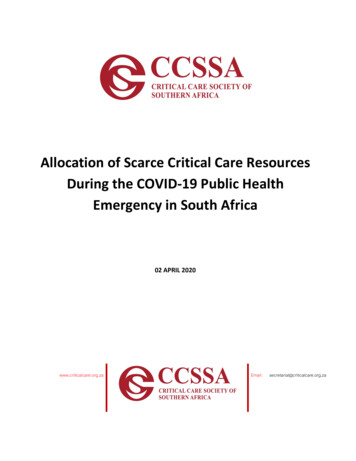
Transcription
LIFE IN THEAGE OF DRONEWARFAREL I S A PA R K S A N D C A R E N K A P L A N , EditorsDUKE UNIVERSITY PRESSD U R H A M A N D LO N D O N2017
2017 Duke University PressAll rights reservedPrinted in the United States of Amer i ca on acid- free paper Text design by Adrianna SuttonCover design by Matthew TauchTypeset in Sabon and Din by Westchester Publishing ServicesLibrary of Congress Cataloging- in- Publication DataNames: Parks, Lisa, editor. Kaplan, Caren, [date–] editor.Title: Life in the age of drone warfare / Lisa Parks and Caren Kaplan, editors.Description: Durham : Duke University Press, 2017. Includes bibliographical referencesand index. Description based on print version rec ord and cip data providedby publisher; resource not viewed. Identifiers: lccn 2017014021 (print) lccn 2017016815 (ebook)isbn 9780822372813 (ebook)isbn 9780822369585 (hardcover : alk. paper)isbn 9780822369738 (pbk. : alk. paper)Subjects: lcsh: Drone aircraft. Air warfare. Drone aircraft pi lots.Classification: lcc ug1242.d7 (ebook) lcc ug1242.d7 l54 2017 (print) ddc 358.4/14— dc23lc rec ord available at https:// lccn.loc . gov / 2017014021Cover art: Drone Shadow installation by James Bridle (jamesbridle.com), Ljubljana,2015. Photograph courtesy of Aksioma Institute for Contemporary Art.
CONTENTSAcknowl edgments I N T R O D U CT I O NviiL I S A PA R K S A N D C A R E N K A P L A N 1PA RT I . J U R I D I C A L , G E N E A LO G I C A L ,A N D G E O P O L I T I C A L I M A G I N A R I E S 231D I RT Y D A N C I N GDrones and Death in the BorderlandsDEREK GREGORY2 25L A W FA R E A N D A R M E D C O N F L I CT SA Comparative Analy sis of Israeli and U.S. Targeted Killing Policiesand Legal Challenges against ThemLISA HAJJAR3 59AMERICAN K AMIK AZETelevision- Guided Assault Drones in World War IIK AT H E R I N E C H A N D L E R4 89( I M ) M AT E R I A L T E R R O RIncitement to Vio lence Discourse as Racializing Technologyin the War on TerrorANDREA MILLER5 112V E RT I C A L M E D I AT I O N A N D T H E U . S . D R O N E W A RIN THE HORN OF AFRICAL I S A PA R K S 134PA RT I I . P E R C E P T I O N A N D P E R S P E CT I V E6 159D R O N E - O - R A M ATroubling the Temporal and Spatial Logics of Distance WarfareCAREN KAPLAN 161
7 D R O N O LO G I E SOr Twice- Told TalesRICARDO DOMINGUEZ 1788 I N P U R S U I T O F OT H E R N E T W O R K SDrone Art and Accelerationist AestheticsTHOMAS STUBBLEFIELD 1959 T H E C O N TA I N M E N T Z O N EM A D I H A TA H I R 22010 S TO N E R S , S TO N E S , A N D D R O N E STransnational South Asian Visuality from Above and BelowA N J A L I N AT H 241PA RT I I I . B I O P O L I T I C S , A U TO M AT I O N ,A N D R O B OT I C S 25911 TA K I N G P E O P L E O U TDrones, Media/Weapons, and the Coming HumanectomyJ E R E M Y PA C K E R A N D J O S H U A R E E V E S 26112 T H E L A B O R O F S U R V E I L L A N C E A N DB U R E A U C R AT I Z E D K I L L I N GNew Subjectivities of Military Drone OperatorsPETER ASARO 28213 L E T T E R F R O M A S E N S O R O P E R ATO RB R A N D O N B R YA N T 31514 M AT E R I A L I T I E S O F T H E R O B OT I CJORDAN CRANDALL 32415 D R O N E I M A G I N A R I E SThe Technopolitics of Visuality in Postcolony and EmpireI N D E R PA L G R E W A LBibliographyContributorsIndex 415 367 411 343
ACKNOWL E DGMENTSLife in the Age of Drone Warfare emerged through a series of dialoguesbetween media, communication, and cultural studies scholars, artists, sociologists, feminists, geographers, journalists, phi los o phers, and science andtechnology studies specialists during the past several years. The collectionbegan to germinate during the Drones at Home conference at the University of California– San Diego in 2012, or ga nized by Jordan Crandall andRicardo Dominguez, and further evolved during the Sensing the Long War:Sites, Signals and Sounds workshop at the University of California– Davis,the Life in the Age of Drones symposium at the University of California– Santa Barbara in 2013, and the Eyes in the Skies: Drones and the Politicsof Distance Warfare conference at uc Davis in 2016. We are grateful to theMilitarization Research Group, the Mellon Digital Cultures Initiative, theDepartment of American Studies, and the Cultural Studies Gradu ate Groupat uc Davis and the Center for Information Technology and Society, Interdisciplinary Humanities Institute, and Department of Film and Media Studies at uc Santa Barbara, whose support enabled us to deepen and expandour discussions and understandings of drone technologies and pro cesses ofmilitarization. We also thank Arthur and Marilouise Kroker for their vitalinterventions at the uc San Diego and uc Santa Barbara events. Their provocations continue to reverberate and have marked this proj ect in numerousways. In addition, we are grateful to all the conference, workshop, and symposium participants for their stimulating pre sen ta tions and artworks, manyof which are included in this book. Other scholars and activists who havesupported and inspired us include Javier Arbona, M. Ryan Calo, DeborahCowen, Lindsey Dillon, Kris Fallon, Emily Gilbert, Casey Cooper Johnson,Léopold Lambert, Nancy Mancias (code pink), Minoo Moallem, TrevorPaglen, Marko Peljhan, Kriss Ravetto- Biagioli, Alex Rivera, Rebecca Stein,Jennifer Terry, and Federica Timeto. We also thank Abby Hinsman for editorial assistance as this proj ect was getting off the ground.
viii A cknowl edgmentsAs our ideas for the Life in the Age of Drone Warfare collection began tocohere, we w ere very fortunate to connect with editor Courtney Berger, whohas been supportive, thoughtful, and enthusiastic throughout the editorialpro cess. We are grateful for her commitment to this proj ect and the manner in which she helped it come to fruition. We also thank Sandra Korn andSusan Albury at Duke University Press for their careful readings and attentionto detail and for being extremely helpful editorial associates. We are indebtedto this book’s contributors for their significant chapters, ongoing commitmentto the proj ect and the issues it addresses, and their collegiality. Our deepestgratitude goes to Andrea Miller, who worked tirelessly as an editorial assistantduring vari ous stages of the manuscript’s preparation. Simply put, the proj ect could not have happened without her myriad efforts. Fi nally, the proj ectbenefited from the insightful reviews of three anonymous readers, whose comments were enormously helpful as we moved the proj ect toward completion.Beyond those mentioned above, we would like to thank Brandon Bryantfor his openness to participate in this proj ect, despite challenges he continues to face as a veteran and whistle blower. Caren Kaplan thanks her facultyand gradu ate student colleagues in American Studies (especially her department chair, Julie Sze) and Cultural Studies at uc Davis for sharing theirwork and supporting her research interests with such enthusiasm. She alsothanks Eric Smoodin and Sofia Smoodin- Kaplan for all kinds of supporton the home front and Marisol de la Cadena, Inderpal Grewal, MeredithMiller, Minoo Moallem, Ella Shohat, and Jennifer Terry for their friendshipand interest in this work. She also extends a big thanks to Lisa Parks forconceiving this proj ect and getting it started before inviting her to join ascoeditor— working together has been a joyful experience. Lisa Parks thanksthe faculty, gradu ate students, and staff in the Department of Film and MediaStudies at uc Santa Barbara for providing a stimulating, supportive, and funwork environment for so many years, and expresses gratitude to her new colleagues in Comparative Media Studies/Writing at MIT for creating new opportunities and a dynamic place to work. She also thanks from the bottom ofher heart John Harley, Jennifer Holt, Moya Luckett, Constance Penley, RitaRaley, Cristina Venegas, and Janet Walker for their incredible friendship andsupport over the years, and conveys her deepest gratitude to Caren Kaplanfor being an exceptional coeditor, scholar, and friend.
INTRODUCTIONL I S A PA R K S A N D C A R E N K A P L A NS I N C E 2 0 0 9, U.S. news media have had a virtual love affair with the drone.Celebrating the alleged novelty and flexibility of the technology, reporters have pointed to a proliferating array of quirky or surprising drone uses,ranging from pizza delivery to pornography recording, from the maintenanceof energy plants to the protection of wildlife, from graffiti writing to trafficmonitoring.1 Drones, we are told, are used in sectors as diverse as real estate, art photography, natu ral resource development, insurance, sports, meteorology, and activism.2 They perform tasks that are too risky, remote, ormundane for humans, whether monitoring lava inside a volcano, mea sur ingwinds inside a hurricane, or performing safety inspections on aircraft. ToyPredators are sold out because of their popularity. Fears of proliferatingdrones in domestic airspace have spurred new regulations and legislation,prompting Chicago to become a no-drone zone.3 Despite such regulations,drones have even fallen on the White House lawn.4 It is impossible to keepup with all the drone news. So much reporting on drones has appearedthat Caren Kaplan refers to it in her chapter in this book as the “drone- o- rama”—an immersion in the sights and sounds of an expanding “military- industrial- media- entertainment network” that now includes views capturedby robotic hummingbirds and remote- controlled quadcopters.5In addition to this flood of news features about the playful and pragmaticpotentials of drones, the drone- o- rama has included a steady stream of reporting on the more somber topics of drone warfare and targeted killing.Investigative reporter Jane Mayer first broke the story about the CentralIntelligence Agency’s (cia) drone war in Pakistan in 2009.6 Since then, awhirlwind of public commentary has emerged on drone warfare. The UnitedNations (un) has conducted special investigations, activists have protested,policy experts have deliberated, news agencies have queried, and researchers have published lengthy reports.7 The drone obsession has also struck the
2 L isa Parks and C aren K aplanU.S. Congress, which now runs an “unmanned systems caucus” made up offifty members from twenty- nine states (with the co- chairs from border statesCalifornia and Texas). Since 2009, the caucus’s congressional membershave garnered close to two million dollars from drone manufacturers suchas Northrup Grumman, General Atomics, and Lockheed Martin.8 Thus,drones are not only envisioned as a pivotal technology in U.S. counterterrorism efforts, but politicians and manufacturers have colluded to ramp upthe expansion of the civilian drone sector. In 2014 digital behemoth Googlepurchased drone manufacturer Titan Aerospace, promising to use drones tobring Internet access to the planet’s most remote and underserved regions.While some news media have played up the friendlier, neoliberal side ofthe technology, emphasizing its capacity to handle a multitude of tasks and,in the pro cess, make life easier while expanding the global economy,9 otherreports have raised serious questions about the ethics of drone warfare,covered anti- drone demonstrations, or honed in on instances of technological failure. Some drone coverage has even verged on the uncanny. Pointingsi mul ta neously to the intrusiveness and frailty of the drone, several reports,for instance, have featured ea gles attacking drones in midair, w hether aspart of a natu ral predator hierarchy or as a result of training by military orpolice units.10 To be sure, the drone has become a contested object. Whiledrone strikes are routinely reported in most mainstream news outlets, whatis often missing from the reportage is an understanding of the materialecologies through which drones are operationalized. These ecologies havebeen depicted in fictional tele vi sion series such as Homeland and 24, filmssuch as Eye in the Sky, and computer games like Drone: Shadow Strike andthe Call of Duty series, yet the narrative logic of t hese media often (thoughnot always) works to legitimate or reinforce militaristic drone use, even ifproviding win dows of opportunity to question it.Life in the Age of Drone Warfare zeroes in on the militaristic histories,uses, cultures, and affects of drone technology. Heeding Derek Gregory’scall to move beyond the “technical (or techno- cultural) object” to the wider“matrix of military vio lence” that such “remote platforms help to activate,”this volume brings together scholars and artists who explore the historical, juridical, geopo liti cal, and cultural dimensions of drone technology andwarfare and sets out to deepen and expand the public discussions initiatedizationsby investigative reporters, activists, and nongovernmental organ (ngos).11 While 91 percent of the U.S. public is aware of U.S. military droneoperations,12 oppositional voices are often marginalized and sidelined in
I n t r o d u ct i o n 3public sphere discussions, as evidenced by activists who have infiltratedcongressional hearings and protested at manufacturers’ gates in efforts tohave their voices heard. Sometimes t hese voices come from within militaryinstitutions. Whistle blowers such as Brandon Bryant, who has a chapterin this book, and Michael Haas deci ded to break the code of silence andspeak publicly about their grim experiences as drone sensor operators, andhave appeared in news media such as Bryant’s 2013 interview with nbc’sRichard Engel or in documentaries such as Drone (2014), directed by TonjeHessen Schei. Artivist proj ects, such as James Bridle’s Dronestagram, whichlinks Google imagery to drone target details circulated by the Bureau ofInvestigative Journalism, or the “Out of Sight, Out of Mind” narrative datavisualization proj ect by the Pitch Interactive design studio, offer thought- provoking challenges to U.S. officials and publics who continue to ignorethe devastating effects of drone warfare.13 In an effort to draw further attention to U.S. drone wars, artist Joseph DeLappe’s 2014 proj ect, In DronesWe Trust, asks participants to rubber stamp a tiny image of a Predatordrone onto the empty sky on the back of U.S. currency. Describing thiscrowd- sourced intervention, DeLappe indicates: “It seems appropriate, considering our current use of drones in foreign skies, to symbolically bringthem home to fly over our most notable patriotic structures.”14Militarized Unmanned Aerial VehiclesDrones or unmanned aerial vehicles (uavs) w ere first developed for militaryreconnaissance, surveillance, and intelligence during the early twentieth century and w ere part of a major push t oward “airpower” and aerial policing that had colonial roots.15 By the early twentieth century, aircraft couldfly in the sky unmanned and be remotely controlled to gather informationabout objects or activities on the ground. During World War II, the UnitedStates began arming experimental aerial drones with bombs and missilesin efforts to compete with Japa nese kamikazes, as discussed in KatherineChandler’s chapter in this book. The use of U.S. drones for surveillance continued during the Vietnam War. In the early 1980s, the Israeli Air Force successfully integrated drones into a full- fledged battle plan, and, as LisaHajjar discusses in her chapter, by the 1990s, Israel and the United States were using drones to support military operations and conduct targeted killings in the Occupied Territories and the former Yugo slavia, respectively. These situations proved that drones could be used not only to locate and
4 L isa Parks and C aren K aplanmonitor “suspects” or “enemies” but also to assassinate them from above. After 9/11, the drone warfare practices tested during the 1990s w ere redirected to fight a global war on terror, and U.S. use of drones for targetedkillings dramatically escalated. As Hugh Gusterson has argued, drones“respatialize war, change its pace, and rework conventional military notions of honor and courage.”16 The respatialization of war has producedwhat Keith Feldman refers to as “racialization from above,” recasting“Orientalist imagined geography” through new scales of relation and division along with transformations in the temporality of “pre- emption andendurance.”17Since the 9/11 attacks, the United States has increased its use of dronesin two parallel programs, one overtly operated by the military and the othera covert program of the cia. Ostensibly directed against al- Qaeda operatives in Pakistan and Yemen and Al- Shabaab forces in Somalia, and nowincreasingly deployed in relation to actions taken against the Islamic Statein greater Syria, the U.S. drone program has raised many l egal, cultural, andpo liti cal questions, including the following: What and where is the battlefield? Who is a combatant? Which laws apply?18 Public discomfort and suspicion of targeted assassinations conducted by remote pi lots stationed inair- conditioned rooms on bases thousands of miles away from the zone ofconflict have not led to any appreciable change in policy. While proponentsof autonomous weaponry characterize it as a “humane” form of warfare,highlighting its alleged efficiency, surgical precision, and minimal casualties,critics insist that drone war is far from humane since it has been waged in anundeclared and illegal fashion, killed or injured thousands of civilians, andtraumatized people living in places that become geopo liti cally designatedas “trou ble spots.” Since 2001, U.S. drone operators have killed and/or injured thousands of suspected “terrorists” and innocent civilians in Af ghan i stan, Iraq, Pakistan, Yemen, and Somalia, many of whom have never beencounted or identified.19 The explosive force of Hellfire missiles dropped byU.S. drones often incinerates bodies, leaving them unrecognizable. Theseextrajudicial killings by the United States have drawn staunch criticism fromthe international community and have catalyzed organ izations such as codepink, the Bureau of Investigative Journalism, Global Drones Watch, BanWeaponized Drones, No Drones Network, Reprieve, and the Campaign toStop Killer Robots to work with activists and ngos in South Asia and the Middle East to form an anti- drone movement and seek redress for victims.Increasingly, as accounts from former drone operators like Brandon Bryant
I n t r o d u ct i o n 5and o thers suggest, remote warfare using high- resolution digital imagingcan result in adverse effects on those who conduct war remotely.Just as there has been a surge in news media coverage on drone technology and anti- drone activism, so too has t here been a burst of scholarlypublishing on the topic. When we started working on this proj ect in 2012, there was only one book focused exclusively on military drone use— Drone Warfare: Killing by Remote Control by code pink founder MedeaBenjamin— and a handful of other books and articles featured discussionsof the technology. More recently, the amount of scholarly work on droneshas skyrocketed.20 That scholars from so many fields have gravitated to thedrone in droves motivates us to ask why. Multiple pos si ble explanationsexist. First, we are living through an era of dramatic technological transformation, of digitization, automation, and robotics, and the drone is bothdriving and manifesting these pro cesses and as such fits neatly into researchon key technological questions. Second, the unpre ce dented use of drones bythe United States for targeted killings in the context of the war on terrorhas prompted scholars to consider how these circumstances challenge existing theories of sovereignty, warfare, and ethics and w hether they violatenational and/or international law. Third, the technical infrastructures thatsupport drone operations facilitate the orchestration of war from a distance—as a system of remote control played out at game- like interfaces— and suchconditions have provoked scholarly interest in the l abor, psychic, and affective dimensions of drone warfare, particularly among drone operatorsor “remote pi lots.” Fi nally, there has been a plethora of scholarship on theoptics or visualities and other sensing practices of drone warfare, whichranges from analyses of military drone screens and visions of the world toconsiderations of “drone phenomenologies” to tactical drone media createdby artists/activists who set out to publicize these optics as a way of contesting this military paradigm.21 In short, the drone has been such an avidobject of scholarly focus precisely b ecause it connects to so many dif fer ent issues, from digitization to sovereignty, from surveillance to geopolitics,from labor to affect. The question is, how long will scholarly focus on thedrone persist? What kinds of questions about vio lence, politics, and targeting are engendered through t hese debates and conversations? Most importantly, we have to ask whether critical scholarly responses to the rapid riseof the use of unmanned aerial vehicles in specifically designated theaters ofwar will have any impact on the policies surrounding drone operations, thenext generation of the technology, or those impacted by its use.22
6 L isa Parks and C aren K aplanDronology: Recent Works on Drone WarfareWhile books and articles about drone technology and warfare abound, t hereare several works that informed this book proj ect in its early stages. Asalready mentioned, in addition to Jane Mayer’s New Yorker article, MedeaBenjamin’s Drone Warfare: Killing by Remote Control was the first bookto critique the cia’s drone war in Af ghan i stan and Pakistan, document theexplosive growth of the drone industry, and signal the rise of anti- droneactivism. Also in the activist vein was Nick Turse and Tom Englehardt’s Terminator Planet: The First History of Drone Warfare, 2001–2050. In 2012Shahzad Bashir and Robert D. Crews published Under the Drones: ModernLives in the Afghanistan- Pakistan Borderlands, a work that, despite its title,addresses a very wide array of social, cultural, and po liti cal issues inthe region beyond the threats drones pose to civilians. Discussions of thetechnology have surfaced, as well, in other widely read recent works suchas P. W. Singer’s Wired for War: The Robotics Revolution and Conflict inthe Twenty- First Century, M. Shane Riza’s Killing without Heart: Limitson Robotic Warfare in an Age of Per sis tent Conflict, and Adam Rothstein’sDrone. In addition, there has been a recent spate of critical scholarship onthe politics of verticality, which we deem to be relevant to drone research:for example, the work of Eyal Weizman, Stephen Graham, and Laura Kurgan.23 Fi nally, the explosion of scholarship on algorithmic practices andpreemption of risk in security cultures is particularly germane to any examination of the po liti cal and technological context of drone warfare; h erewe are thinking specifically of the work of Louise Amoore and Marieke deGoede as well as Jutta Weber.24Derek Gregory and Grégoire Chamayou have published some of themost influential and widely cited critical scholarship on drone technologyand warfare. In a series of key articles, Gregory has addressed a range of issues, from the “new visibilities” and “scopic regime” of drone war to its expanding definition of the “civilian” in a “drone geography,” from the lethallogistics of the “kill chain” to the screened intimacies of drone operators.25The geographies of drone warfare in Gregory’s groundbreaking work movefrom the ground control stations, where sensor operators practice the doctrine of “projecting power without vulnerability,” to the variable scales ofintimacy and distance as mediated through material relations and technologies, to the transforming battlefield as targeting shifts from an areaor structure, to, in many cases of assassination, an individual.26 There is
I n t r o d u ct i o n 7prob ably no other cultural critic at work today who has done more to trace these geographies of military power and the ways in which po liti cal vio lence is enacted, justified, and resisted. Gregory’s newest research on dronewarfare, which appears in the first chapter of this book, offers a painstaking analy sis of the rise of “targeted killing” and its production of “spacesof exception.”With the recent En glish translation of Grégoire Chamayou’s Théoriedu drone, this French phi los o pher’s work has circulated more widely andgenerated more comment. Chamayou begins with the assumption that thedrone has altered the general conditions of war and undertakes a philosophical, ethical, and genealogical analy sis of the technology. His genealogymoves from automatons in the early twentieth c entury to kamikazes during World War II, from unmanned systems deployed in Israel and Vietnamto the Predators and Reapers currently aloft. For Chamayou, the droneturns humans into prey and war into a “militarized manhunt” that idealizesasymmetry, enabling the hunter- killer to kill without being killed and to seewithout being seen.27 Chamayou confronts a range of vital issues— fromrelations of reciprocity to necro- ethics, from precision to automation— yet,as Ian Shaw has argued, in privileging ethics, the book has other agendasthan to engage drone technology as inherent to a “history of U.S. empireand global vio lence,” evacuating key historical instances, such as the ColdWar.28 This kind of metaphysics, Benjamin Noys insists, can ascribe “agencyand activity that flatters the drone as object” while eliding “the intricatemeshing with h uman l abor that makes drone operations pos si ble.”29 Thebalance between material analy sis and metaphysical theory, between new ormisrecognized sources and classic Eurocentric histories, and other antinomies of long standing can be difficult to negotiate. Considered together, recent work on drone warfare advances our understanding of the “full matrix,”as Gregory puts it, of the ways in which war is being conducted “everywhere” as well as “somewhere” with significant repercussions for everydaylife in an era of shifting battlespaces.30Along t hese lines, Life in the Age of Drone Warfare provides contexts,concepts, and examples that encourage further interrogation and critiqueof drone warfare and drone- related militarization. What distinguishes thisbook from other works, however, is a privileging of critical humanities, poststructuralist, and feminist perspectives. Life in the Age of Drone Warfareexplores how the imagination and usage of military drones has made pos si ble or affected par tic ul ar kinds of material conditions and e mbodiments,
8 L isa Parks and C aren K aplan hether in Israel/Palestine or the Horn of Africa, the Federally AdministeredwTribal Areas (fata) region of Pakistan or the U.S.- Mexico border. To thinkabout life in the age of drone warfare is to recognize the stretch betweenground and sky as a field of strategic operations, world histories, and biopolitics. It is to recognize the ways military technologies are entangled withmodes of perception and practices of knowledge. And it is to acknowledgethe need for sustained critical inquiry around foundational categories suchas body and machine, distance and proximity, self and Other, life and death.To think about life in the age of drone warfare, in other words, is to situatethis flying apparatus within the frictions and factions of power. That thedrone has maneuvered into so many sectors is also suggestive of the capacity of its militarizing tendencies to permeate life conditions. Too often thediscussion of drones transpires in broad brushstrokes and top- down modesthat often have the effect of endorsing current drone policy and practicerather than questioning the technology’s public subsidies, uses, and effects.What is missing from existing scholarly work on drones is a critique of thetechnology that recognizes its imbrication within cultural imaginaries, biopolitics, difference, and perception.To expand the critical analy sis of drone technology, this book engageswith perspectives from fields such as media and communications studies,geography, sociology, art, literary studies, journalism, feminist and queertheory, and subaltern studies, fields that approach the drone as a technologyof power as well as a part of everyday life. Some of the questions exploredin this book are: How does drone use intensify power asymmetries in theworld and where? How do uses of this “unmanned” technology relate toissues of embodiment, subjectivity, and subjectivation? How is everyday lifein dif fer ent parts of the world changing in relation to the use of drones?What does it mean to sense the Earth’s surface from the perspective of thedrone, and how does that information manifest and circulate? What kindsof po liti cal practices and imaginaries are produced by the new forms ofspatialization in targeting and the reor ga ni za tion of lived experience produced by drone warfare? Life in the Age of Drone Warfare builds upon andextends the work mentioned above by drawing more focused attention tojuridical relations, cultural imaginaries, and biopo liti cal formations.Despite de cades of feminist research on science, technology, and milirelated articlestarization, only a handful of recently published drone- explic itly engage with feminist epistemologies.31 Crucially, some of this re-
I n t r o d u ct i o n 9search builds upon Donna Haraway’s critique of science and technologyto foreground the gendered dynamics of unmanned systems and the agential capacities of drone interfaces.32 Most drone research averts feministperspectives either by ignoring them completely or absorbing their basicarguments and precepts without acknowl edgment. This book, in embracing an openly feminist approach, takes as axiomatic that gender/sexuality,race/ethnicity, class, and national identities are constituted intersectio
Caren Kaplan thanks her faculty and graduate student colleagues in American Studies (especially her depart-ment chair, Julie Sze) and Cultural Studies at uc Davis for sharing their work and supporting her research interests with such enthusiasm. She also thanks Eric Smoodin and Sofia Smoodin-Kaplan for all kinds of support











